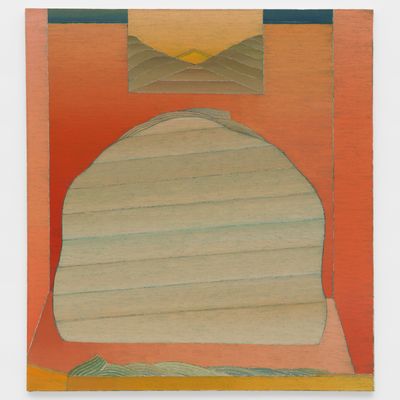
The 16 paintings by Miyoko Ito on display at Matthew Marks Gallery glow densely with color, as if lit by some inner sun. The canvases of some of the best works here — most from the 1970s, painted when she was in her 50s — are nailed to the edges of the stretcher so that the raised heads are visible. This gives the paintings a studded halo, like sacred tapestries. They slow us down and accentuate our “here-ness,” offering an introspective realm to enter.
Ito died in 1983 at the age of 65. She said she worked “sunrise to sunset,” seven days a week, while raising two children in Chicago. I met her twice there in the 1970s. I remember her as being small, intense, very quiet, taking it all in at a distance, like there were ghosts in the room with her. She was one of the rulers of the Chicago roost, part of a group called the Chicago Imagists — artists who didn’t work in the minimal or conceptual forms of New York and Los Angeles. Instead, they veered into figuration, cartooning, fantasy, and wild color. These artists included Jim Nutt, Gladys Nilsson, Roger Brown, Ed Paschke, Barbara Rossi, Karl Wirsum, Christina Ramberg, and Ray Yoshida. Yet even after the art world caught up to Imagism, Ito remained overlooked. She is only now starting to get her due; her art would stand out in any museum collection.
Back in the 1970s, she was not only one of the few non-white artists on the scene, but also older than her peers — an outsider among outsiders. Born to Japanese parents in 1918, her father worked as a houseboy in California. When he struggled to support his family there, Ito was taken by her mother to live with relatives near Nagoya, Japan. The family arrived September 1923, one day after the Yokohama earthquake that killed over 140,000 people. It was chaos. Her mother soon gave birth to a stillborn child.
“Everything was terribly traumatic,” Ito said. “Going to school was very traumatic. I was very, very ill, extremely ill, to the point that I couldn’t walk anymore.” She had what she called a “childhood nervous breakdown.” Of her parents, she said, “My parents were very irresponsible.” Her father “grew up all by himself and he didn’t know how to treat a child, and I didn’t know how to behave as a child.” Yet of her time in Japan, she said, “Those five years are the roots of what I am.”
In 1928, Ito and her family settled in Berkeley, in a neighborhood she identified as “predominantly black” and “a third Japanese and very few whites and the whites were Portuguese.” She said, “You cannot help but be race conscious when you’re segregated.”
One month before she graduated from UC Berkeley in 1942, Ito’s family was placed in a Japanese internment camp south of San Francisco. By then, she’d met a boy her parents forbade her to see because, she said, “his brother had married a pariah, an untouchable.” No matter: In 1942, the couple married to avoid being separated in the camps. While Ito was allowed to attend Smith College the following year, her husband remained interned until 1945.
In 1944, she moved to Chicago, where she spent the rest of her life. Her art career there was up and down. After being rejected from a show in 1955, she said, “To be called an old lady painter, passé at the age of 30 or 31, is very hard to take.” Nevertheless, she was featured in numerous exhibitions, including the Whitney Biennial and the Carnegie International, and was awarded a Guggenheim Fellowship in 1977. She showed often in Chicago. But sales were few. “That is what I noticed about women painters,” she said. “They would go on no matter what. Some men painters will become so discouraged after a big splash.” Painting, she said, “is the only healing thing in my life.”
At Marks, we feel the hours, days, and years she invested in her art; the circumspection, diligence, and determination. Surfaces build up like grained fresco. Creamsicle salmon colors bask in sunshine. Paint strokes are orderly, never gestural, giving her work an underlying solidity and structure. Beads and bumps of paint accumulate, scrapes and abrasions appear, furrows form. How these paintings were made is as much a part of the work as what they look like. One of the most beguiling aspects of her art are the tiny spaces between her larger forms. They fill her paintings with shimmers of supernal otherness.
If those five years from her childhood in Japan lie at the root of Ito’s life, they also inform her art. There are forms that resemble shrines and the ancient tomb mounds surrounding Nagoya. There is a flatness and a descending order of images that recall a calligraphic scroll. Ito is painting what Rilke has called the “inner space” that “has its being in you” — quiet sanctuaries where the past lives on.

